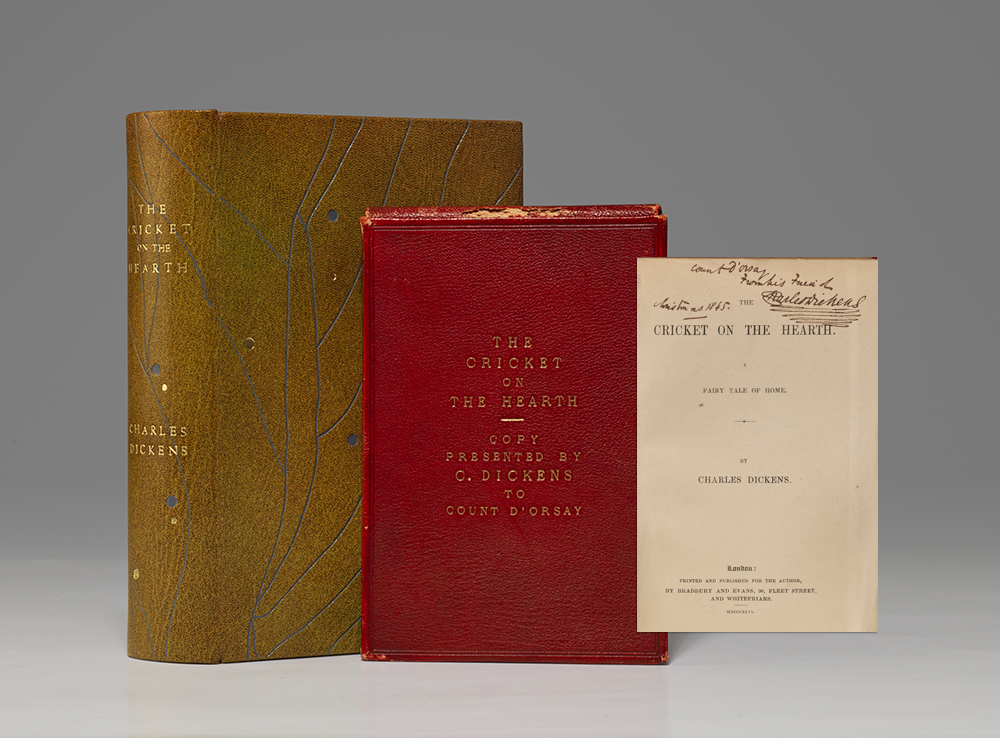Description
WARMLY PRESENTED AND INSCRIBED BY CHARLES DICKENS FOR CHRISTMAS TO HIS CLOSE FRIEND ALFRED, COUNT D’ORSAY—GODFATHER OF HIS SIXTH CHILD, WHOM DICKENS NAMED AFTER THE COUNT: HIS THIRD CHRISTMAS BOOK, THE CRICKET ON THE HEARTH
DICKENS, Charles. The Cricket on the Hearth. A Fairy Tale of Home. London: Bradbury & Evans, 1846. 12mo, original red cloth gilt, all edges gilt. Housed in a custom morocco slipcase with flap.
First edition of Dickens’ third Christmas book, a very rare and desirable copy presented by Dickens to one of his most intimate friends, the profligate French artist and socialite Alfred Guillaume Gabriel, Count D’Orsay—godfather of Dickens’ sixth child, Alfred D’Orsay Tennyson Dickens—inscribed on the title page “Count d’Orsay from his friend Charles Dickens Christmas 1845.” A superb copy in the original cloth, with distinguished provenance.
Alfred Guillaume Gabriel, Count D’Orsay (1801-1852) the handsome Frenchman, accomplished portrait artist (he made portraits of Queen Victoria and Lord Wellington), and inveterate gambler, whom Thomas Carlyle called the “Phoebus Apollo of dandyism” was “…one of the sights of London as he drove from his little house in Curzon Street to Hyde Park. To his smart, hooded cabriolet was harnessed a seventeen-hand horse, and behind, clinging to the straps, bounced a tiny tiger. The reins were handled in white kid gloves his wristbands were turned back over his coat cuffs …” (Pope-Hennessey). With his mistress Marguerite Gardiner, Countess of Blessington, D’Orsay was leader of the artistic and fashionable world of London. They gathered round them in their drawing room at Gore House, Kensington, the social and literary celebrities of their day. Dickens had long looked to emulate such dilettantes as Disraeli, Bulwer Lytton (who were frequent guests), and D’Orsay himself, whose glittering dandyism would inspire some of his own later extravagances. In May of 1836 Dickens found his entree into their society. Lady Blessington had asked Serjeant Talfourd to bring a young writer to one of her soirees to help entertain the aging Walter Savage Landor: “I wish to procure for him as much enjoyment as I can” she wrote to him. Dickens was to become one of D’Orsay’s most intimate friends, and with his and Blessington’s influence Dickens was soon in demand; the “kind of young man that every artist wanted to paint and every hostess to see in her salon.” (Pope-Hennessey). In 1845 Lord Alfred Tennyson stood with D’Orsay as joint godfather and namesake of Dickens’ sixth child Alfred D’Orsay Tennyson Dickens: “the extraordinary name aroused a considerable amount of not altogether friendly comment. Edward Fitzgerald took it as evidence that Dickens was a snob: ‘For what is Snobbishness and Cockneyism, but such pretensions and parade?'” (Johnson). Robert Browning teased that whereas Tennyson was the godfather, D’Orsay was the devilfather. By 1849 D’Orsay could no longer avoid his creditors and fled to France, where he died in 1852.A number of commentators have seen D’Orsay as the part-inspiration of a number of characters in the fiction of Dickens, who based many of his characters on real individuals that he met over the course of his life.
Dickens created a new literary genre with his annual Christmas books. Beginning in 1843 with the publication of A Christmas Carol, Dickens published five Christmas-themed books at holiday time. The Cricket on the Hearth was the third in the series, and “it is said to rank second in importance as a Christmas Book” after A Christmas Carol (Eckel, 119). The Cricket on the Hearth was published on 20 December 1845, the title page postdated 1846. It proved enormously popular, doubling the circulation of its predecessors, with the first edition sold out by the end of the year. First printing, with second state of advertising leaf at rear (as usual). With engraved frontispiece and additional title and 12 wood-engraved illustrations after Leech, Doyle, Stanfield, Maclise and Landseer. Smith II:6. Gimbel A92. Eckel, 119-20. As befitting such a splendid presentation copy, the book has spent the last century in the leading collections of Dickens. Alongside D’Orsay’s own bookplate on the front pastedown are three other plates. Firstly that of the Comte Alain de Suzannet (who recorded in his own catalogue that he purchased it for £400 from J. E. S. Sawter), sold in his sale 22 November 1971, lot 85; then Kenyon Starling; bequeathed to William E. Self; finally in the Lawrence Drizen collection of Charles Dickens, dispersed in 2019. Decades of careful ownership have ensured that the book—often found sunned and worn—here remains in remarkably fresh condition.
Just a touch of rubbing to joints. Still a fine, bright copy.



